Arts & Entertainment Community
Day Tripper | Bainbridge packs a lot of fun into a small island
Despite having lived in the Gig Harbor area for 30 years, I can only remember visiting Bainbridge Island twice. The first time was basically a pass through between Poulsbo and the Winslow ferry. The second time was when I went to meet Pia the Peacekeeper, one of the famous Dambo Trolls. After the second visit, it wasn’t a question of whether I should come back, but when. The time is now.
I had no idea that the Bainbridge Island area had so many interesting places to investigate. I’m not too bad at making decisions; my only failing (if you can call it that) is that I want to know my full range of options before making said decision. Sometimes, when planning a trip, I could be accused of spending more time agonizing about which route to take than it would take to just get in the car and go there.
Thankfully, Bainbridge Island has a very limited range of options. There are only two ways on and off the island. The first is to travel Highway 305 through Poulsbo and across the Agate Pass Bridge. That takes a little over an hour, per Google Maps.
The second is by the Seattle-Bainbridge Island ferry, which shares a terminal on the east side with the Seattle-Bremerton route at Pier 52. That takes longer than an hour, but involves a pleasant ferry ride.
I visited the Island on Juneteenth, aka June 19 (that will be relevant later). I didn’t figure riding the ferry or driving I-5 on a holiday were great ideas, so I took Option 1 and traveled by land.
Agate Pass Bridge
The Agate Pass Bridge is 37 miles from Gig Harbor. It is a steel truss cantilever bridge that cost $1.3 million to build in 1950. It was initially a toll bridge until the bond issued to repay the construction costs was fully satisfied in October 1951.
The bridge is 1,229 feet long and is 75 feet above the water, with a channel clearance of 300 feet between piers. By comparison, the eastbound Narrows Bridge is 5,400 feet long with a main span of 2,799 feet, making it the fifth-largest suspension bridge in the United States.
I had hoped to get a picture of the bridge, but there was absolutely no nearby parking. I’m always looking for ways to take a great (or at least decent) picture to enhance these stories, but there was no way I was risking my life to get it. This wasn’t the last time I was forced to make that decision on this trip. Now that I found myself cruising across the bridge unable to find a safe place to stop, I decided to go all the way to the ferry dock and make my way back exploring on the way. 7.2 miles later, I was there.
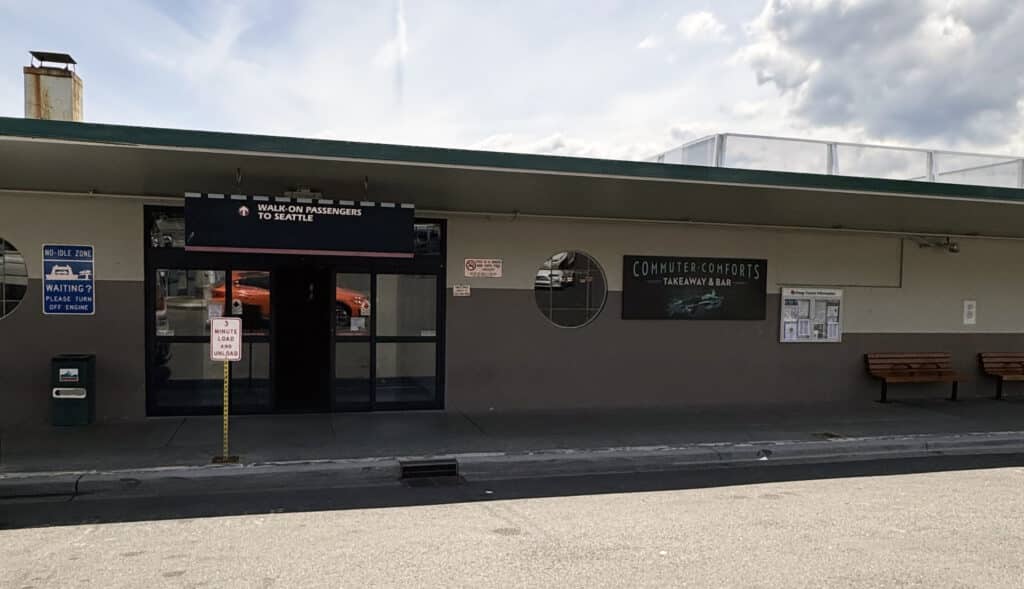
The Bainbridge Island ferry terminal. Photo by Mary Williams
If everything goes as planned, the Bainbridge Island ferry motors into Eagle Harbor 33 minutes after departing Seattle. A short walk up a fairly gentle hill leads to Winslow Way, with its shopping area and the Bainbridge Island Creative District.
We’ve visited Creative Districts before. A program of ArtsWA, a Creative District combines places to live, work, and visit. It’s a geographically defined area of cultural and economic activity combined with places where community members gather and enjoy arts and culture.
In many ways, Bainbridge reminds me a lot of Gig Harbor. Its very walkable main street has won a number of awards, and it has a summer hanging basket program that makes you feel like you’re walking through a garden.
The area was originally a Native American settlement and the local Suquamish Tribe had several names for it. In 1792, Captain George Vancouver landed on the southern tip of the Island, which he named Restoration Point. When Lt. Charles Wilkes led another expedition in 1841, he named the island in honor of Commodore William Bainbridge, a close friend.
In 1947, 132 residents surrounding the residential and business core of Eagle Harbor voted to incorporate the city of Winslow. The population at the time was 905. In 1991, the rest of the island annexed into the city; the new municipality called itself Bainbridge Island, instead of Winslow.
The neighborhood around the ferry dock — island old-timers still call that neighborhood Winslow — includes a lot of sites to see. The Bainbridge Island History Museum wants to make it easy for you to find them, so it created four walking tours and a driving tour. I suggest you print them and decide what you want to see based on your own interests and the amount of time you have.
I’ll highlight a few of the places I wanted to check out so that you can decide if you’d like to visit them, too. Since it was the first place I saw after parking at the ferry terminal, I started with the beautiful Bainbridge Island Art Museum.
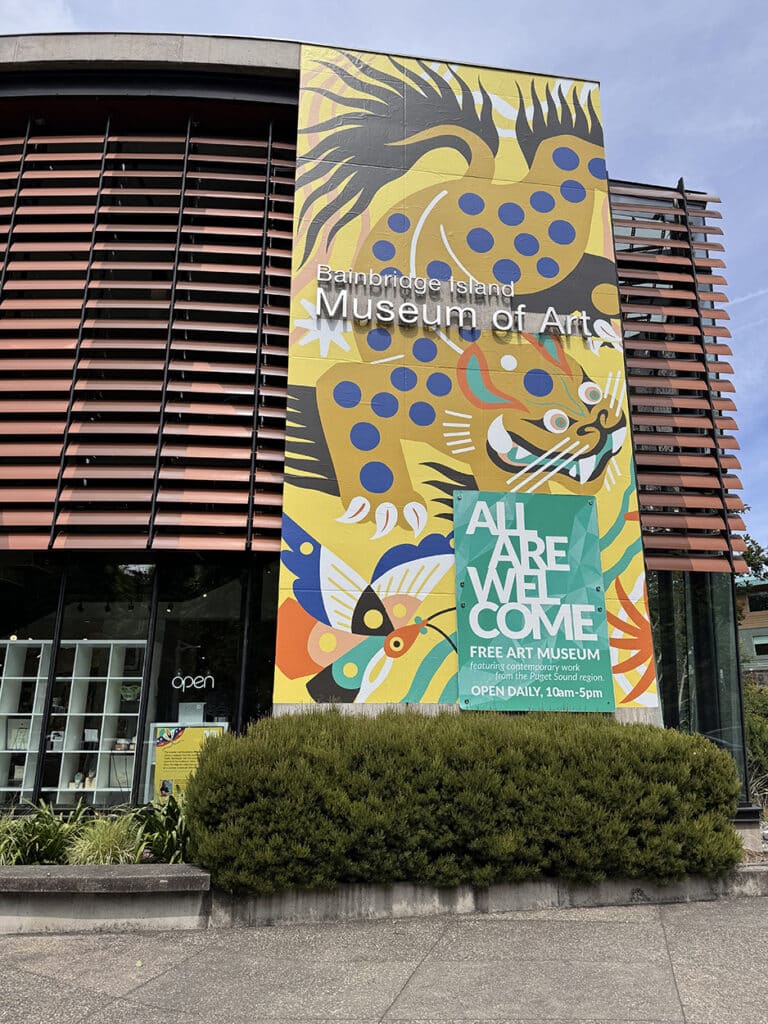
The Bainbridge Island Museum of Art. Photo by Mary Williams
Located at 550 Winslow Way East (the corner of Highway 305 and Winslow Way), the museum is part of what’s known as The Island Gateway. Right behind it is the Kids Discovery Museum.

The Bainbridge Art Museum (BIMA), opened in 2013, houses a growing permanent art collection focusing on artists and collections from the Puget Sound region.
The museum is home to galleries, an auditorium, a bistro, a store and the plaza. Major exhibitions change three times each year. Most of the galleries are currently closed for a change-over, but will open again around Sept. 1. It also offers classes, tours, films, workshops, lectures, concerts and events.
BIMA is open every day and admission is free.
The history museum is just a couple blocks away on Ericksen Street. Walking between the two, you will cross a ravine via a footbridge. You have arrived at the intersection of geology, ecology, and commerce.
Winslow Ravine
A sign on the bridge on Winslow Way explains the history of Winslow Ravine. The ravine itself is lush with greenery. Adjacent to the ravine is the John Nelson Trail, an easy 1.4-mile walk. If you choose to follow the trail, it ends up quite near Sakai Park, the home of Pia the Peacekeeper.
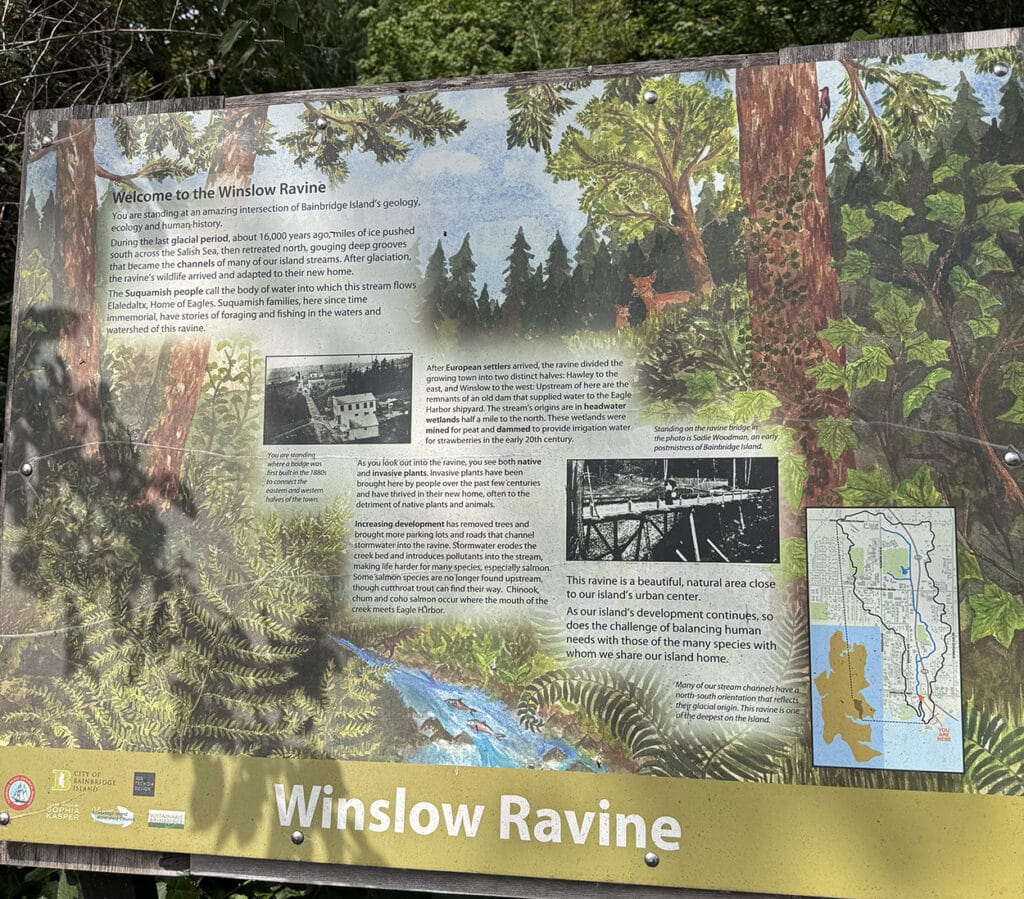
An interpretive sign explains the wonders of Winslow Ravine. Photo by Mary Williams
Very near the start of the trail is the Ravine shopping district. It includes some casual places to eat, shops featuring local art, souvenirs, and gifts, and a tea shop. You can also visit some cute cement friends.
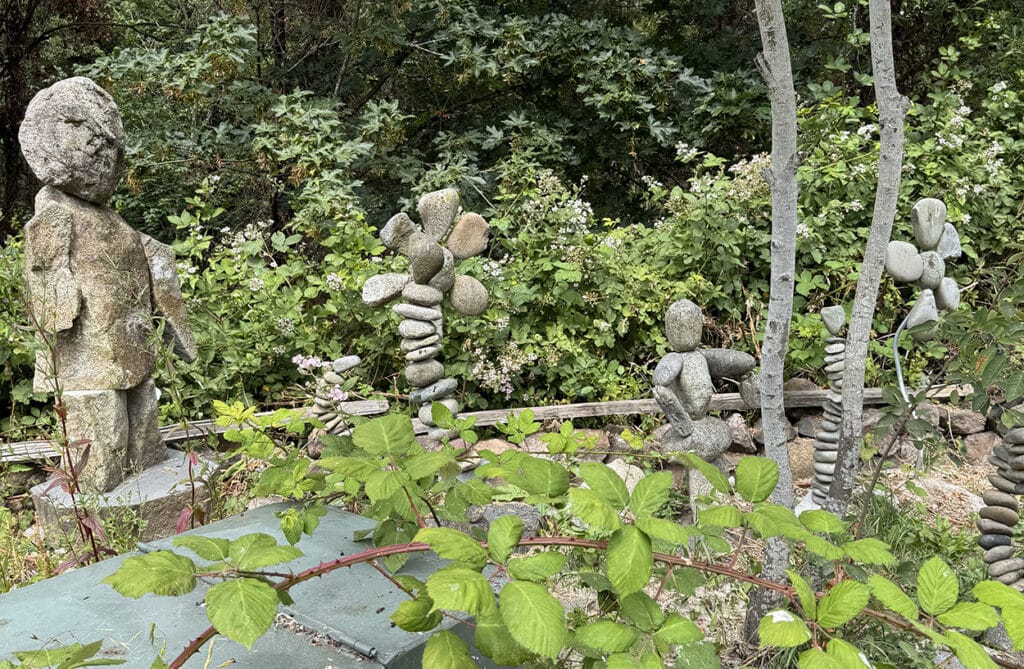
Photo by Mary Williams
The Bainbridge History Museum, which is also reminiscent of Gig Harbor, is just around the next corner at 215 Ericksen Ave. One of the two buildings used to construct it was a red schoolhouse. It is open every day from 10 a.m. to 4 p.m. except for Thanksgiving, Christmas and New Year’s Day, and admission is free.
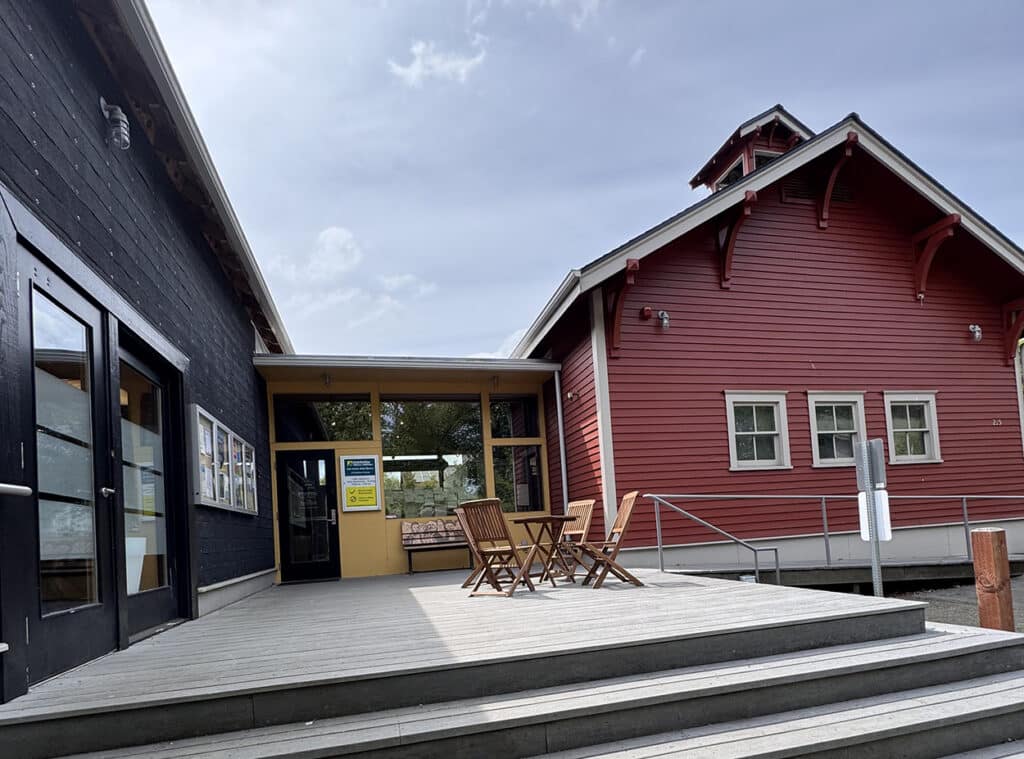
The Bainbridge Island History Museum is made up in part of a former schoolhouse. Photo by Mary Williams
Like most community history museums, this one does a great job of highlighting the important events that over the years have created the Bainbridge Island of today.
Japanese American Exclusion Memorial
Without a doubt, the most memorable and moving part of the day was my visit to the Japanese American Exclusion Memorial. Whether it was the convergence of the coincidence that it happened to be Juneteenth, the constant barrage of news talking about our current political situation and the events happening all around the country, or the stories portrayed on the walls of this Memorial, what I saw and felt really hit home.
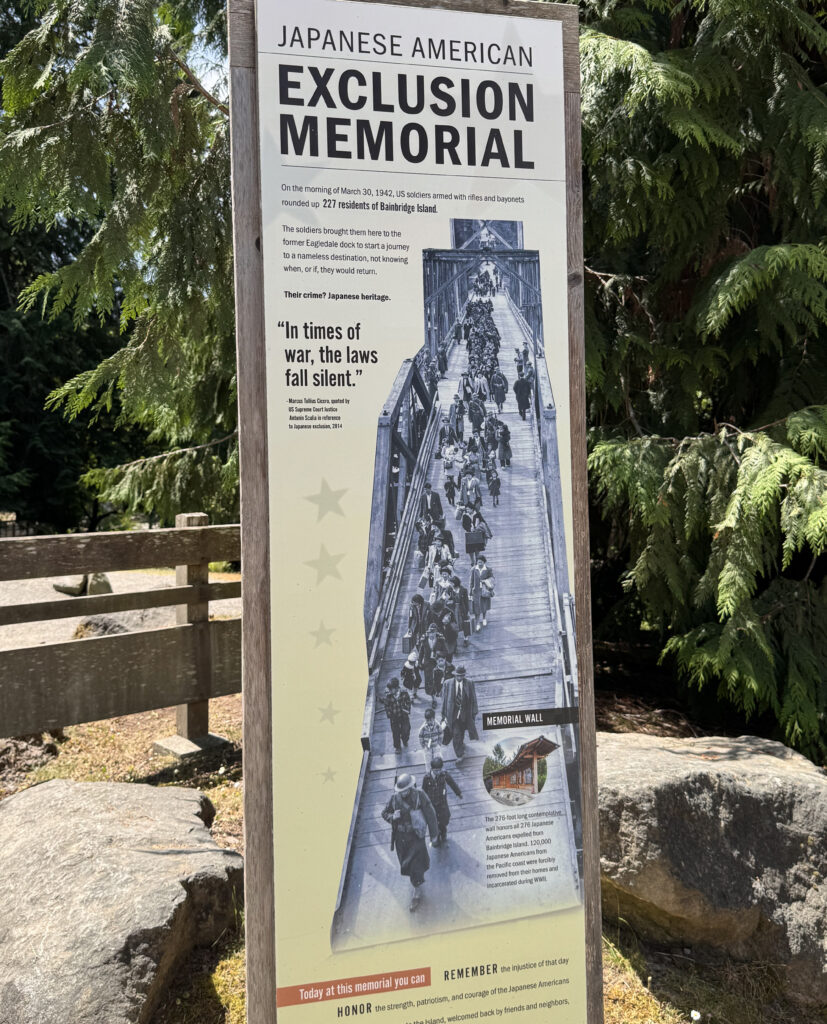
A sign at the entrance to the Japanese American Exclusion Memorial on Bainbridge Island. Photo by Mary Williams
The memorial tells the story of how on March 30, 1942, armed soldiers appeared at the homes of 215 Japanese people, both citizens and non-citizens, rounded them up, forcibly removed them, and incarcerated for the remainder of World War II.
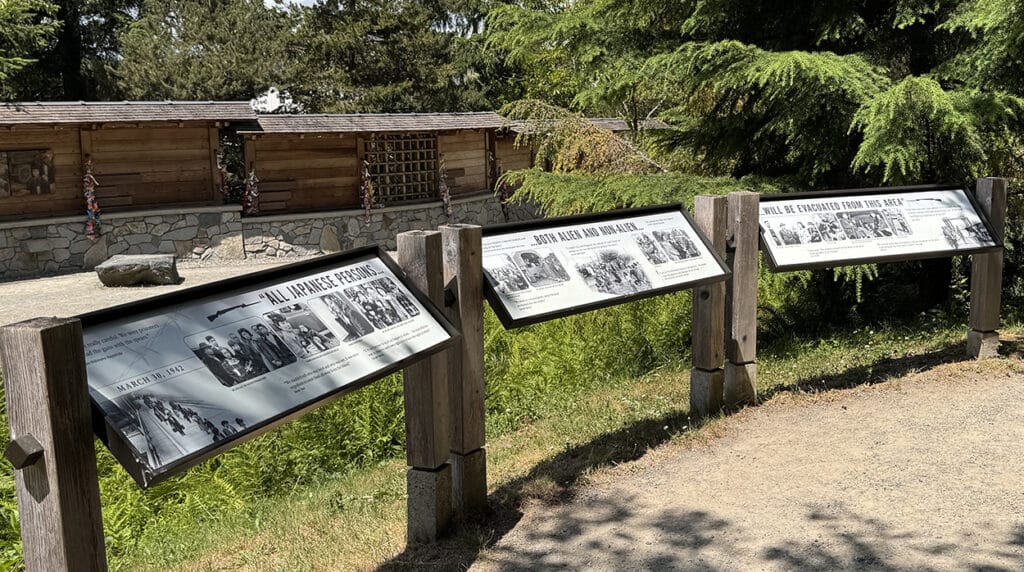
The Japanese-American Exclusion Memorial on Bainbridge Island. Photo by Mary Williams
Operated by the National Park Service, park rangers are often available to lead tours and answer questions. A self-guided walking tour is available on the NPS App. This audio tour takes visitors through the memorial while listening to oral histories directly from survivors.
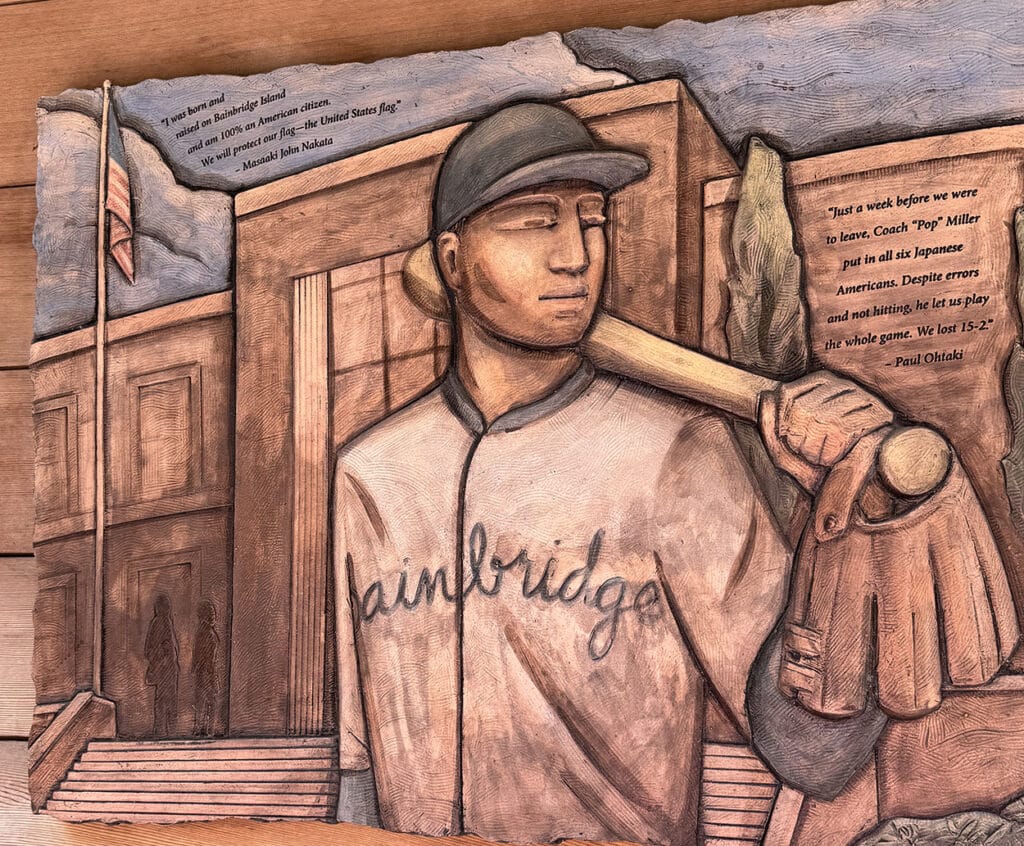
A scene from the Japanese-American Exclusion Memorial on Bainbridge Island. Photo by Mary Williams
The theme of the exhibit is “Let it Not Happen Again.” After several hours of wandering through the exhibits, I left wondering if we’ve learned anything from our past. That sure doesn’t seem to be the case.
The memorial is at 4195 Eagle Harbor Dr. NE, near Joel Pritchard Park. Since I was out that way, I decided to take a quick look at several other nearby areas. The view from Eagle Harbor Drive is amazing. It looked like you could hop in the water and easily swim to Seattle, although everything I’ve been able to find says the water is much too cold to do it. The most likely result would be hypothermia.
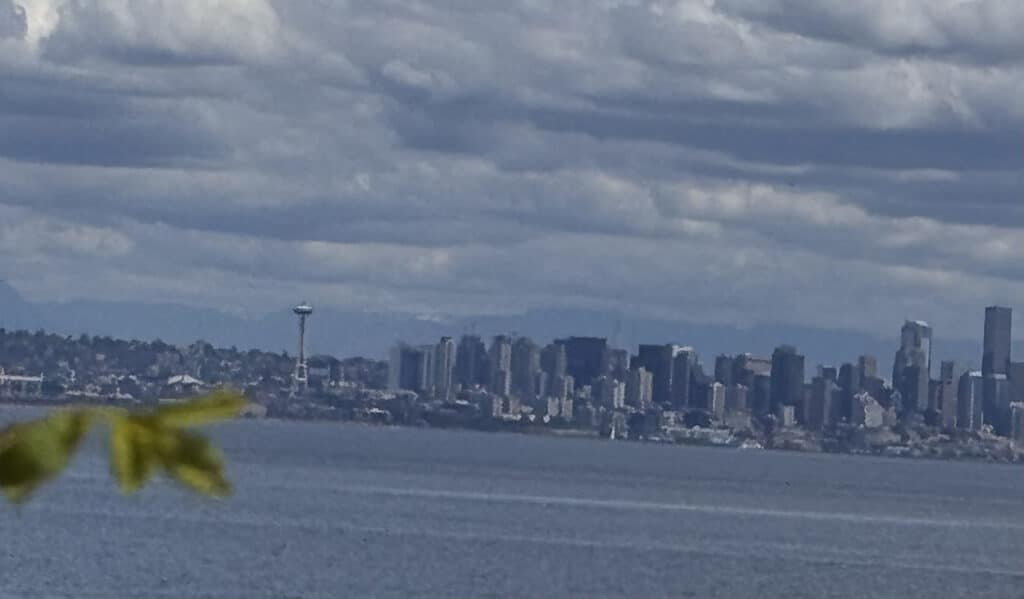
The view of Seattle from Eagle Harbor Drive on Bainbridge Island. Photo by Mary Williams
The birth of pickleball
By now it’s well known that the game of pickleball originated on Bainbridge Island. Three fathers — Joel Pritchard, Bill Bell, and Barney McCallum — were looking for a fun activity for their children and decided to transform an old badminton court. They adapted it by lowering the net and using a ball instead of a shuttlecock.
I tried to find the home and take a look at the original court, but once again parking was impossible. The island is quite proud of this heritage and there are pickleball souvenirs available almost everywhere. If you’re a player, there are also courts around town.
Pia the Peacekeeper
A visit to Bainbridge would not have been complete without stopping by to say hello to our old friend Pia the Peacekeeper, one of Thomas Dambo’s five trolls in the area. And, frankly, after the sobering experience of visiting the Japanese American Exclusion Memorial, I needed a bit of cheering up.
We first visited Pia in October 2023 when she was a brand-new baby (but still giant) troll.
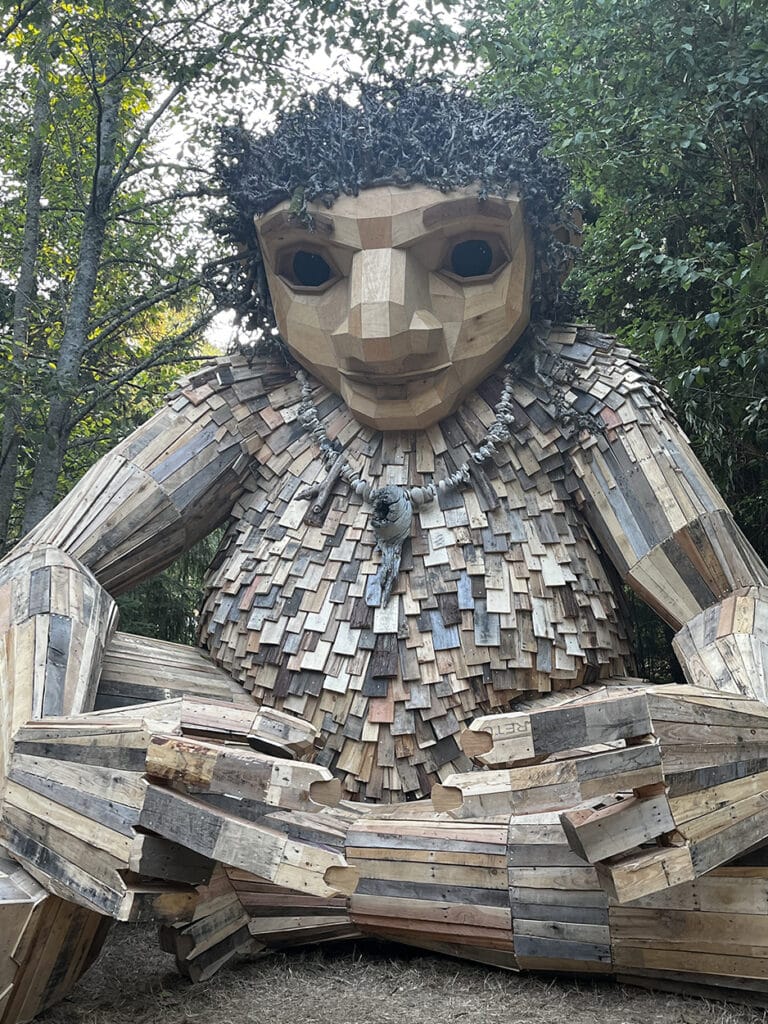
Our old friend Pia the Peacekeeper. Photo by Mary Williams
Pia officially woke up on Aug. 19, 2023, at 8:19 am. She was welcomed with music and a community celebration. Later in the day, a public event to “Wake the Bainbridge Troll” was also held.
Pia, made entirely of recycled material, was built in a week by Danish artist Thomas Dambo and local volunteers. Pia is part of the Northwest Trolls: Way of the Bird King project. The project aims to promote environmental sustainability and celebrate the cultural heritage of the Coast Salish tribes and Danish and Scandinavian traditions.
Pia herself seems a bit different to me. I didn’t notice it so much while visiting, but her before and after pictures show that the one area that seems to be darkening more quickly than others is around her eyes. She looks really tired and worried, and with the state of the world the way it is right now, what Peacekeeper wouldn’t be stressed out.
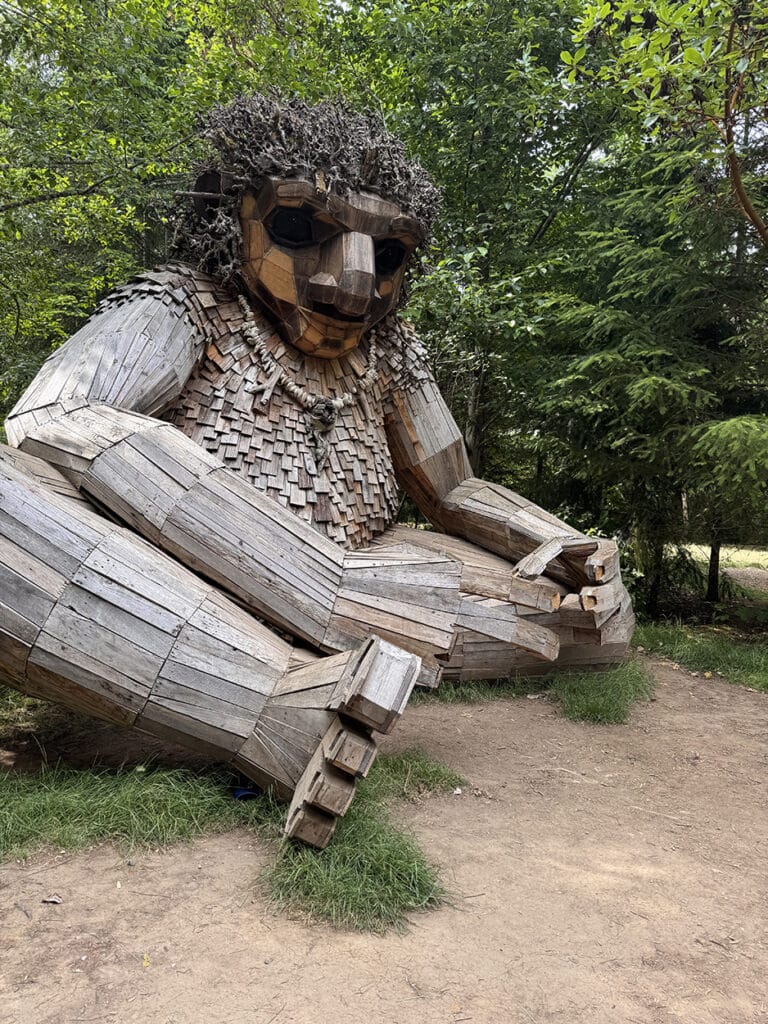
Pia seems more worried than two years ago. Photo by Mary Williams
It was time to leave the area, so I started the return trip to Highway 3 via Highway 305. As I once again approached the Agate Pass Bridge, I decided to check out the Bloedel Reserve.
I’ve been curious about the various green spaces in Western Washington with the name Bloedel attached in some way. There’s Bloedel-Donovan Park in Bellingham, 12.5 acres of lush greenery near the northwest end of Lake Whatcom. And then there’s the Bloedel Reserve on Bainbridge Island, which is 140 acres of landscapes, gardens, and forested areas.
Bloedel Reserve
Originally, I had planned to visit both the Reserve and the rest of Bainbridge Island on the same trip, but my pre-adventure research convinced me that this wasn’t a good idea.
The Reserve is a 150-acre wildlife sanctuary and antique estate with a Japanese garden, a rhododendron glen, and a vast garden with native plants. It features 23 distinct areas within the reserve such as a moss garden and various other themed gardens. There is a house, and a walking path. The path itself is projected to take 2+ hours alone, and I’m guessing that is based on an average speed greater than mine, which is more like a sedated snail. Touring the estate would no doubt take a couple of additional hours..
The process of visiting the Reserve isn’t easy. I had thought I might drive around, take a few pictures, and tell you about it so that if you were interested you could plan your own visit. This is not that kind of place.
This gate and guard house is as close as you can get without paying your admission fee, which ranges from $9 for a child under 12 to $26 for an adult.
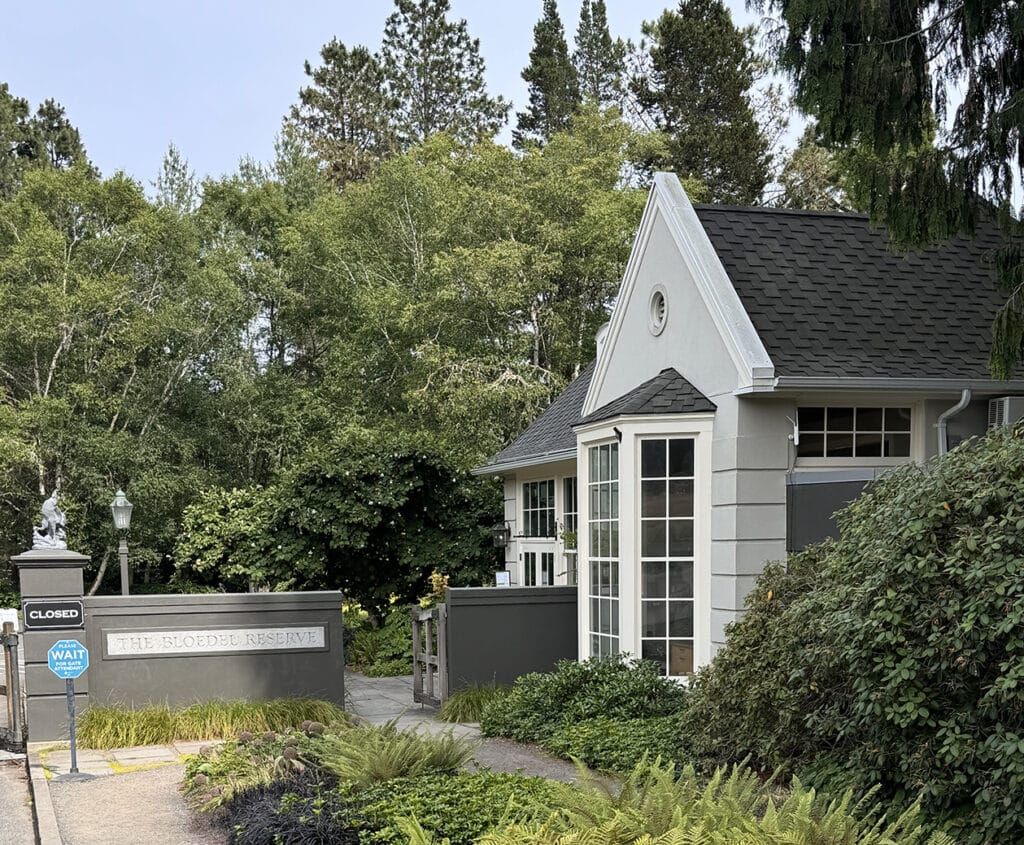
The guardhouse of the Bloedel Reserve on Bainbridge Island. Photo by Mary Williams
I decided that something this popular must warrant a day trip of its own, when it is the primary focus. Therefore, I’ll schedule a return trip in a few months. Maybe then I’ll be able to get close enough to the bridge to get a picture of it, too.
About the Day Tripper column
Gas prices are sky high, and a night in a hotel is approaching astronomically expensive. So, for the foreseeable future, I imagine many of you are going to find yourselves taking day trips rather than the road trip vacations we’ve grown to love.
This beautiful region in which we live is ripe with opportunities to explore new places, see new things, and learn a little something at the same time. I promise to keep the longest journeys to a one-way distance of under 200 miles. Whether you want to make it an overnight trip, a weekend, or just a very long day trip, we should be able to pull it off.
I hope you’ll grant me the honor of your virtual company as we travel these roads together. Happy trails!

